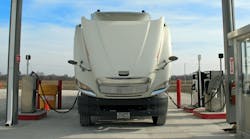As environmental regulations become increasingly strict, alternative fuels such as natural gas can offer similar functionality to conventional diesel, but with much lower greenhouse gas emissions.
"Natural gas engines operate similarly to gasoline engines," says Bob Carrick, natural gas sales manager at Daimler Trucks North America.
Daimler Trucks North America (daimler-trucksnorthamerica.com) produces and markets Class 5-8 trucks, including trucks with alternative fuel solutions.
Natural gas vehicles offer similar power, acceleration and cruising speed compared to conventional diesel or gasoline vehicles. And, according to NGVAmerica (ngvamerica.org), new near-zero gas engines produce 95 percent fewer nitrogen oxide (NOx) emissions than current standards.
"Natural gas is a smart economic and environmental choice for fleets," says Daniel Gage, president of NGVAmerica, an organization dedicated to developing a profitable and sustainable market for natural gas vehicles. "When powered with renewable natural gas, natural gas vehicles can actually provide a net positive impact on greenhouse gas emissions by removing greenhouse gas emissions from landfills, dairy farms, wastewater treatment facilities, etc."
He adds that natural gas vehicle technology is proven and commercially available, making it an ideal choice for fleets considering an alternative fuel.
Types of natural gas vehicles
There are three types of natural gas vehicles:
- Dedicated – Dedicated vehicles have engines that run on a single fuel, either compressed natural gas (CNG) or liquid natural gas (LNG).
- Bi-fuel – These vehicles have two fuels on board: CNG or LNG, and gasoline. Bi-fuel vehicles only run one fuel at a time, but have the option to switch depending on fuel availability or duty cycle.
- Dual-fuel – Dual fuel vehicles also have two fuels on board: CNG or LNG, and diesel. Unlike bi-fuel vehicles, dual fuel engines run on both diesel and natural gas simultaneously. The amount of diesel used varies based on the engine and the duty cycle. Some use a small amount of diesel injected only for ignition, while others are capable of running on only diesel (although not optimally) to return to base when natural gas runs out.
According to the U.S. Department of Energy's Alternative Fuels Data Center, light duty vehicles usually use dedicated or bi-fuel systems, and heavy duty vehicles use dedicated or dual-fuel systems.
Natural gas vehicles are available in light, medium and heavy duty options from OEMs, and medium and heavy duty vehicle options are available through qualified system retrofitters.
Natural gas is available in two forms: LNG and CNG. Both natural gas forms are methane: the difference is the method of storage.
"CNG is high pressure, and is compressed to 3,600 psi for use on the vehicle," says Daimler Trucks' Carrick. "LNG is cryogenically cooled to about 265 degrees below zero, at which point it changes to liquid."
CNG vehicles store natural gas in tanks, and it remains in the gaseous state for use.
The advantage to LNG is that because it is stored as a liquid, it has a higher energy density and is well-suited for Class 7 and 8 trucks that require a greater range. However, it has fewer readily available fueling stations, making it an impractical choice for some fleets.
Buying new versus retrofitting
There are a limited number of available light duty natural gas vehicles from OEMs, although that number is growing. And, there are dedicated and bi-fuel medium duty vehicles available directly from OEMs, as well as heavy duty natural gas vehicle options for applications such as transit buses, school buses and refuse trucks.
"There are several offerings available from heavy duty truck manufacturers to meet customer needs and requirements," says NGVAmerica's Gage. "Tank configurations can vary by the need of the customer depending on range, space on the vehicle, weight, etc."
The advantage to buying a new natural gas vehicle is customization: once the fuel system suppliers and vehicle manufacturers understand the customer needs, they can tailor the fuel system to meet those requirements.
Daimler Trucks' Carrick recommends buying new to ensure that the vehicle operates with maximum efficiency and offers the lowest greenhouse gas emissions. He adds that DTNA only sells new natural gas products and does not offer retrofitting.
Gage adds that there are companies that offer conversions, but OEM warranties may not be extended to conversions.
Vehicles can be converted to dedicated configurations, or to bi-fuel configurations by qualified system retrofitters (QSRs). It is important to work with a reputable conversion shop to ensure that converted vehicles are safe, legal and dependable.
NGVAmerica recommends ensuring that the conversion contract includes the following:
- The conversion kit is EPA or CARB certified and approved for the vehicle model and engine
- The vehicle will comply with applicable federal and state regulations
- The system will fully comply with the current edition of NFPA 52 or later
- CNG cylinders will be labeled, tested and certified in accordance with FMVSS 304
- If used cylinders are installed, the cylinders should be inspected by a certified cylinder inspector and should be good for the life of the vehicle.
Converting current vehicles to natural gas can lower costs versus buying new, but it is important not to compromise safety or quality. Before converting, be sure to ask questions about anything that is unclear, and choose a certified conversion shop with enough experience to meet EPA regulations.
Fueling infrastructure
There are approximately 175,000 natural gas vehicles on the road today, NGVAmerica's Gage says, and over 25 million worldwide.
As the number of natural gas vehicles increases, more fuel stations have opened.
"There are over 1,800 natural gas stations in operation in the U.S," Gage says.
"[Infrastructure] is improving, especially on the CNG side," Daimler Trucks' Carrick adds. "[But] there are still a limited number of LNG stations – less than 100 public access stations."
Some areas, especially metro areas, have a network of natural gas fueling stations that are already established. For fleets operating in these areas, fueling natural gas vehicles only requires planning routes that feature truck-friendly fueling stations.
If there are not currently natural gas fueling stations in your area, you would need to develop your own in-house fueling.
"Some fleets have built their own fueling stations to accommodate their vehicles," Carrick says.
If a fleet decides to develop its own fueling stations, they will first need to decide whether to build CNG or LNG stations, based on the kind of natural gas their vehicles are designed to run on. CNG stations need more equipment and configuration, but LNG stations require more safety precautions when fueling.
The cost of installing natural gas infrastructure varies based on the size, capacity and type of natural gas it dispenses. It also depends on whether the natural gas station is fast-fill or time-fill. Fast-fill stations are designed so that fill times are similar to those for gasoline or diesel fueling stations. Time-fill stations fill vehicles over a longer period of time, and are best suited for fleets with vehicles that fuel at central locations overnight. Time-fill stations can take several hours to fill, but are also typically less expensive.
According to a report published by the Natural Renewable Energy Laboratory, a CNG fueling station can cost up to $1.8 million depending on the size and the application. Smaller fueling units cost an average of $10,000 including installation. For an LNG fueling site, the Energy Information Administration says costs can range from $1 million to $4 million per station.
When installing a natural gas station, it is important that fleets work with their local utility to determine the appropriate level of gas pressure for the location and ensure that the gas quality and moisture content are suitable for the application. This ensures gas service will be able to support the needed gas flow.
The best applications for natural gas vehicles
From a performance standpoint, natural gas vehicles can be used for a variety of applications.
"Freightliner has deployed natural gas trucks and tractors into almost every application," Daimler Trucks' Carrick says. "All Freightliner natural gas vehicles offer the same product benefits as Freightliner diesel-powered vehicles."
Carrick adds that if a customer has the room for the fueling system and access to natural gas, Freightliner can meet the needs of the customer.
According to Daimler Trucks, approximately one percent of the total vehicle volume is now powered by natural gas. Fleets are adapting natural gas because there is a cost difference between CNG and diesel fuel.
"It can be in the $1.50 DGE range, even at today's lower diesel prices," Carrick says.
The current fueling infrastructure limitations make natural gas a good choice for vehicles that are able to have their own fueling site and/or operate in a limited network that has ready access to CNG fueling stations.
"Refuse and transit are good examples of return-to-base fleets [that could benefit from] using natural gas," NGVAmerica's Gage says. "We have seen the largest uptick in adoption in the refuse/recycling industry and transit. Over 60 percent of new refuse/recycling trucks are powered by natural gas."
"The best applications to realize a faster payback (2 to 3 years) are those using 10,000 to 15,000, or more, gallons of fuel per truck per year," Carrick adds.
Trucks using that level of fuel will realize the cost benefits of natural gas over diesel much more quickly, and will also help offset the initial costs of developing the fueling infrastructure to support a natural gas fleet.
Gage notes that fleets switching to natural gas may qualify for government incentives such as tax deductions or credits, reduced license fees, reduced vehicle sales taxes and lower registration fees. These programs can help alleviate costs and improve the fleet's ROI.
If a fleet is considering switching to natural gas, Carrick recommends carefully reviewing routes and applications to ensure that fuel will be available at a consistent, reasonable price and that they are operating in an area where funding is available to improve the ROI. He adds that fleets can mitigate the risk of investing in this alternative fuel by partnering with suppliers who are market leaders in the segment and can anticipate potential unanticipated costs.
"Natural gas is priced competitively with conventional fuels," concludes Gage. "Dollar for dollar, natural gas provides the most NOx emissions reductions."
For local transit and return to base fleets, natural gas vehicles can offer cost savings and cleaner emissions without compromising performance.




